Theories, Principles, and Models of Education and Training Report
VerifiedAdded on 2020/12/29
|30
|9537
|180
Report
AI Summary
This report provides a comprehensive analysis of theories, principles, and models in education and training, covering reflection, learning, communication, assessment, and curriculum. It delves into various models like Gibbs' reflective cycle, Kolb's model, and Jenny Moon's model, exploring their application in reviewing teaching practices and personal experiences. The report examines behaviorism, cognitive, and humanistic learning theories, alongside models of learning preferences. Furthermore, it discusses the application of communication theories and the analysis of assessment and curriculum theories, providing insights into how these models can be applied in educational settings to enhance teaching and learning outcomes. The report offers practical examples and case studies to illustrate the concepts discussed.
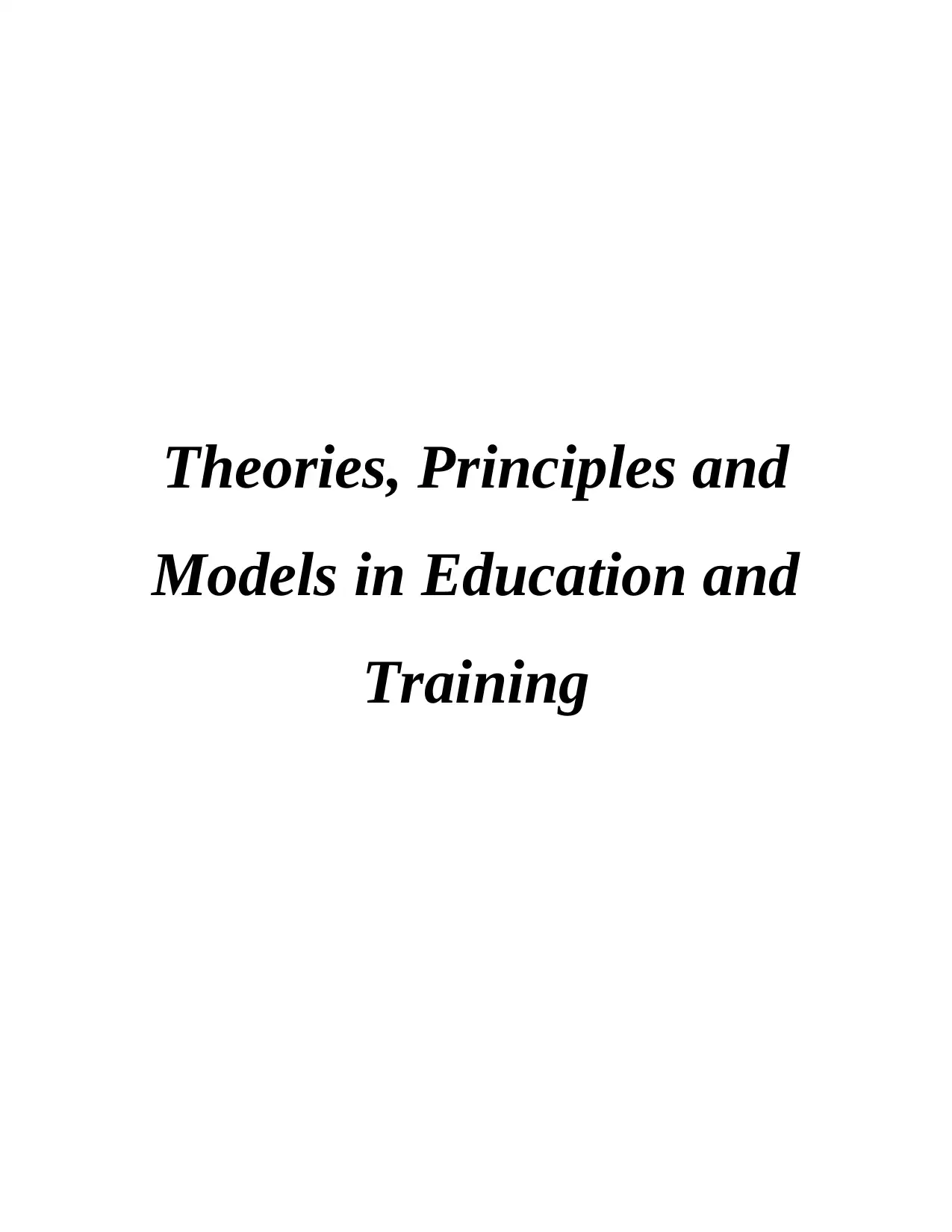
Theories, Principles and
Models in Education and
Training
Models in Education and
Training
Paraphrase This Document
Need a fresh take? Get an instant paraphrase of this document with our AI Paraphraser
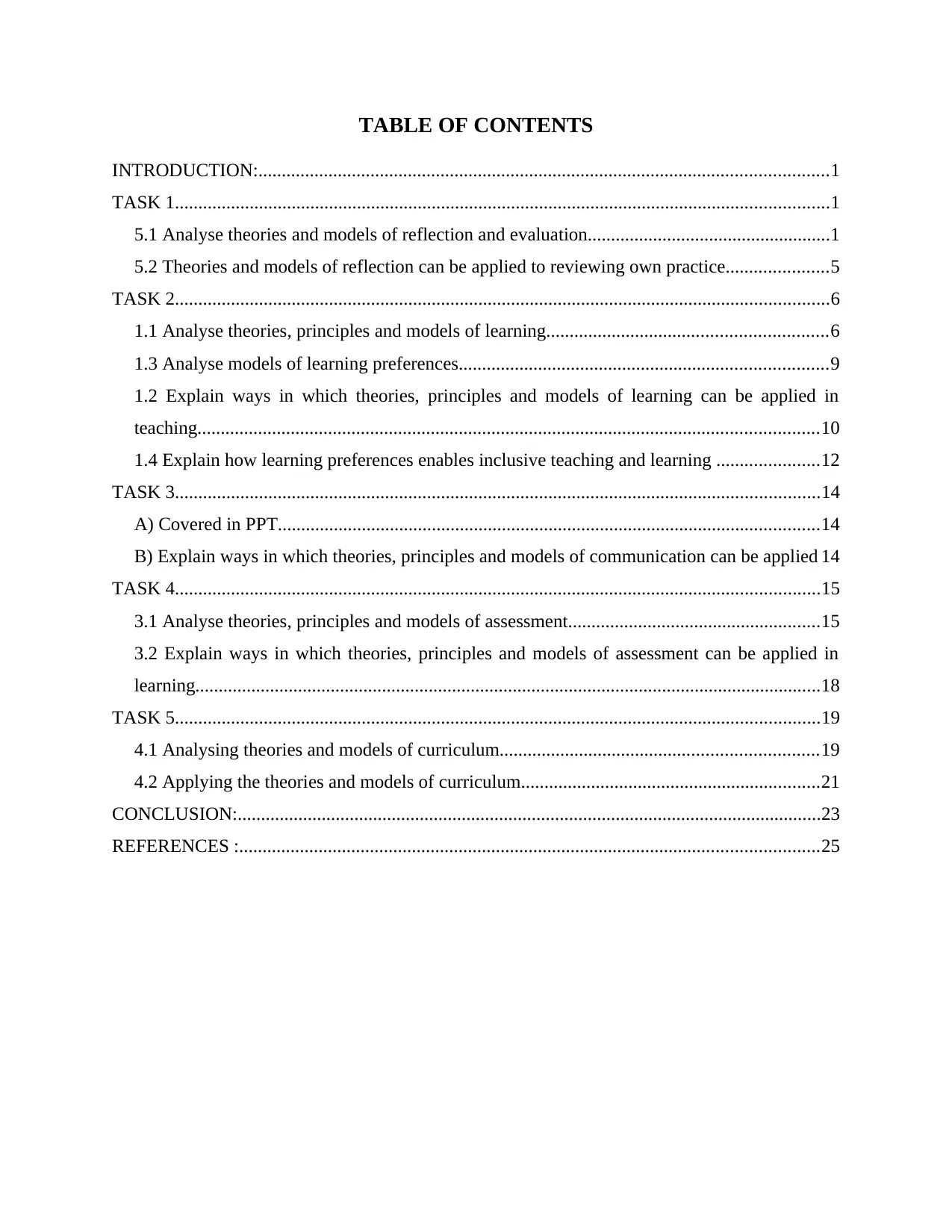
TABLE OF CONTENTS
INTRODUCTION:..........................................................................................................................1
TASK 1............................................................................................................................................1
5.1 Analyse theories and models of reflection and evaluation....................................................1
5.2 Theories and models of reflection can be applied to reviewing own practice......................5
TASK 2............................................................................................................................................6
1.1 Analyse theories, principles and models of learning............................................................6
1.3 Analyse models of learning preferences...............................................................................9
1.2 Explain ways in which theories, principles and models of learning can be applied in
teaching.....................................................................................................................................10
1.4 Explain how learning preferences enables inclusive teaching and learning ......................12
TASK 3..........................................................................................................................................14
A) Covered in PPT....................................................................................................................14
B) Explain ways in which theories, principles and models of communication can be applied 14
TASK 4..........................................................................................................................................15
3.1 Analyse theories, principles and models of assessment......................................................15
3.2 Explain ways in which theories, principles and models of assessment can be applied in
learning......................................................................................................................................18
TASK 5..........................................................................................................................................19
4.1 Analysing theories and models of curriculum....................................................................19
4.2 Applying the theories and models of curriculum................................................................21
CONCLUSION:.............................................................................................................................23
REFERENCES :............................................................................................................................25
INTRODUCTION:..........................................................................................................................1
TASK 1............................................................................................................................................1
5.1 Analyse theories and models of reflection and evaluation....................................................1
5.2 Theories and models of reflection can be applied to reviewing own practice......................5
TASK 2............................................................................................................................................6
1.1 Analyse theories, principles and models of learning............................................................6
1.3 Analyse models of learning preferences...............................................................................9
1.2 Explain ways in which theories, principles and models of learning can be applied in
teaching.....................................................................................................................................10
1.4 Explain how learning preferences enables inclusive teaching and learning ......................12
TASK 3..........................................................................................................................................14
A) Covered in PPT....................................................................................................................14
B) Explain ways in which theories, principles and models of communication can be applied 14
TASK 4..........................................................................................................................................15
3.1 Analyse theories, principles and models of assessment......................................................15
3.2 Explain ways in which theories, principles and models of assessment can be applied in
learning......................................................................................................................................18
TASK 5..........................................................................................................................................19
4.1 Analysing theories and models of curriculum....................................................................19
4.2 Applying the theories and models of curriculum................................................................21
CONCLUSION:.............................................................................................................................23
REFERENCES :............................................................................................................................25
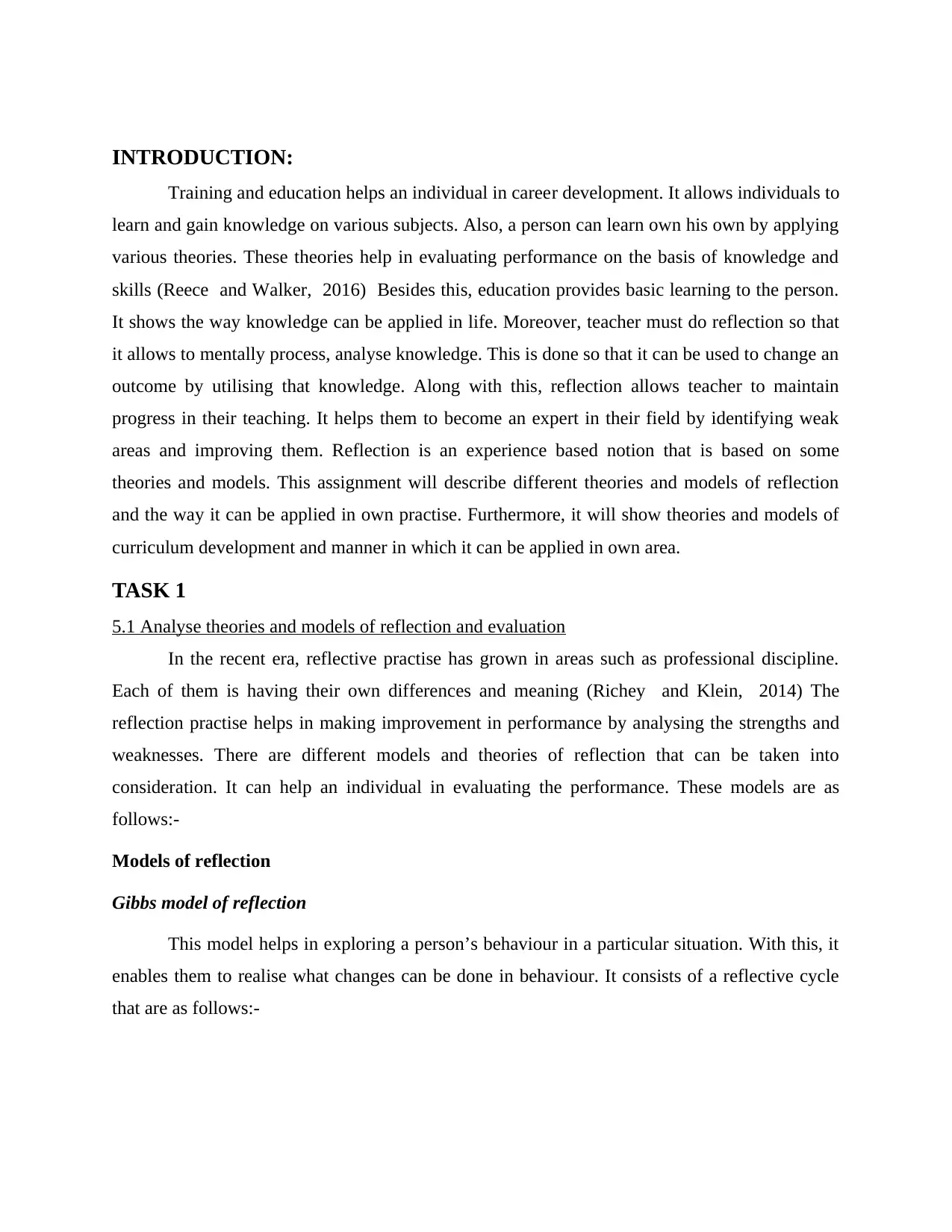
INTRODUCTION:
Training and education helps an individual in career development. It allows individuals to
learn and gain knowledge on various subjects. Also, a person can learn own his own by applying
various theories. These theories help in evaluating performance on the basis of knowledge and
skills (Reece and Walker, 2016) Besides this, education provides basic learning to the person.
It shows the way knowledge can be applied in life. Moreover, teacher must do reflection so that
it allows to mentally process, analyse knowledge. This is done so that it can be used to change an
outcome by utilising that knowledge. Along with this, reflection allows teacher to maintain
progress in their teaching. It helps them to become an expert in their field by identifying weak
areas and improving them. Reflection is an experience based notion that is based on some
theories and models. This assignment will describe different theories and models of reflection
and the way it can be applied in own practise. Furthermore, it will show theories and models of
curriculum development and manner in which it can be applied in own area.
TASK 1
5.1 Analyse theories and models of reflection and evaluation
In the recent era, reflective practise has grown in areas such as professional discipline.
Each of them is having their own differences and meaning (Richey and Klein, 2014) The
reflection practise helps in making improvement in performance by analysing the strengths and
weaknesses. There are different models and theories of reflection that can be taken into
consideration. It can help an individual in evaluating the performance. These models are as
follows:-
Models of reflection
Gibbs model of reflection
This model helps in exploring a person’s behaviour in a particular situation. With this, it
enables them to realise what changes can be done in behaviour. It consists of a reflective cycle
that are as follows:-
Training and education helps an individual in career development. It allows individuals to
learn and gain knowledge on various subjects. Also, a person can learn own his own by applying
various theories. These theories help in evaluating performance on the basis of knowledge and
skills (Reece and Walker, 2016) Besides this, education provides basic learning to the person.
It shows the way knowledge can be applied in life. Moreover, teacher must do reflection so that
it allows to mentally process, analyse knowledge. This is done so that it can be used to change an
outcome by utilising that knowledge. Along with this, reflection allows teacher to maintain
progress in their teaching. It helps them to become an expert in their field by identifying weak
areas and improving them. Reflection is an experience based notion that is based on some
theories and models. This assignment will describe different theories and models of reflection
and the way it can be applied in own practise. Furthermore, it will show theories and models of
curriculum development and manner in which it can be applied in own area.
TASK 1
5.1 Analyse theories and models of reflection and evaluation
In the recent era, reflective practise has grown in areas such as professional discipline.
Each of them is having their own differences and meaning (Richey and Klein, 2014) The
reflection practise helps in making improvement in performance by analysing the strengths and
weaknesses. There are different models and theories of reflection that can be taken into
consideration. It can help an individual in evaluating the performance. These models are as
follows:-
Models of reflection
Gibbs model of reflection
This model helps in exploring a person’s behaviour in a particular situation. With this, it
enables them to realise what changes can be done in behaviour. It consists of a reflective cycle
that are as follows:-
⊘ This is a preview!⊘
Do you want full access?
Subscribe today to unlock all pages.

Trusted by 1+ million students worldwide
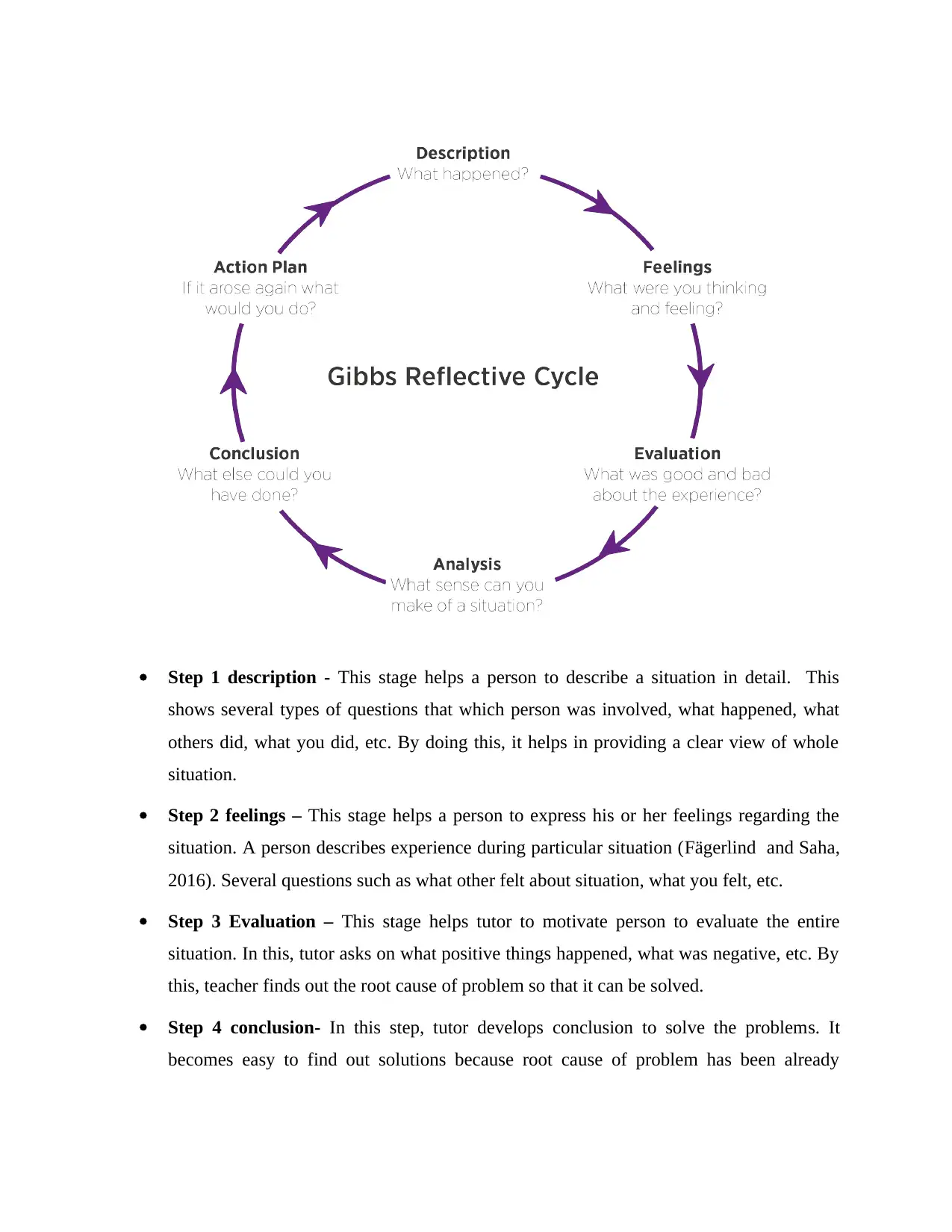
Step 1 description - This stage helps a person to describe a situation in detail. This
shows several types of questions that which person was involved, what happened, what
others did, what you did, etc. By doing this, it helps in providing a clear view of whole
situation.
Step 2 feelings – This stage helps a person to express his or her feelings regarding the
situation. A person describes experience during particular situation (Fägerlind and Saha,
2016). Several questions such as what other felt about situation, what you felt, etc.
Step 3 Evaluation – This stage helps tutor to motivate person to evaluate the entire
situation. In this, tutor asks on what positive things happened, what was negative, etc. By
this, teacher finds out the root cause of problem so that it can be solved.
Step 4 conclusion- In this step, tutor develops conclusion to solve the problems. It
becomes easy to find out solutions because root cause of problem has been already
shows several types of questions that which person was involved, what happened, what
others did, what you did, etc. By doing this, it helps in providing a clear view of whole
situation.
Step 2 feelings – This stage helps a person to express his or her feelings regarding the
situation. A person describes experience during particular situation (Fägerlind and Saha,
2016). Several questions such as what other felt about situation, what you felt, etc.
Step 3 Evaluation – This stage helps tutor to motivate person to evaluate the entire
situation. In this, tutor asks on what positive things happened, what was negative, etc. By
this, teacher finds out the root cause of problem so that it can be solved.
Step 4 conclusion- In this step, tutor develops conclusion to solve the problems. It
becomes easy to find out solutions because root cause of problem has been already
Paraphrase This Document
Need a fresh take? Get an instant paraphrase of this document with our AI Paraphraser
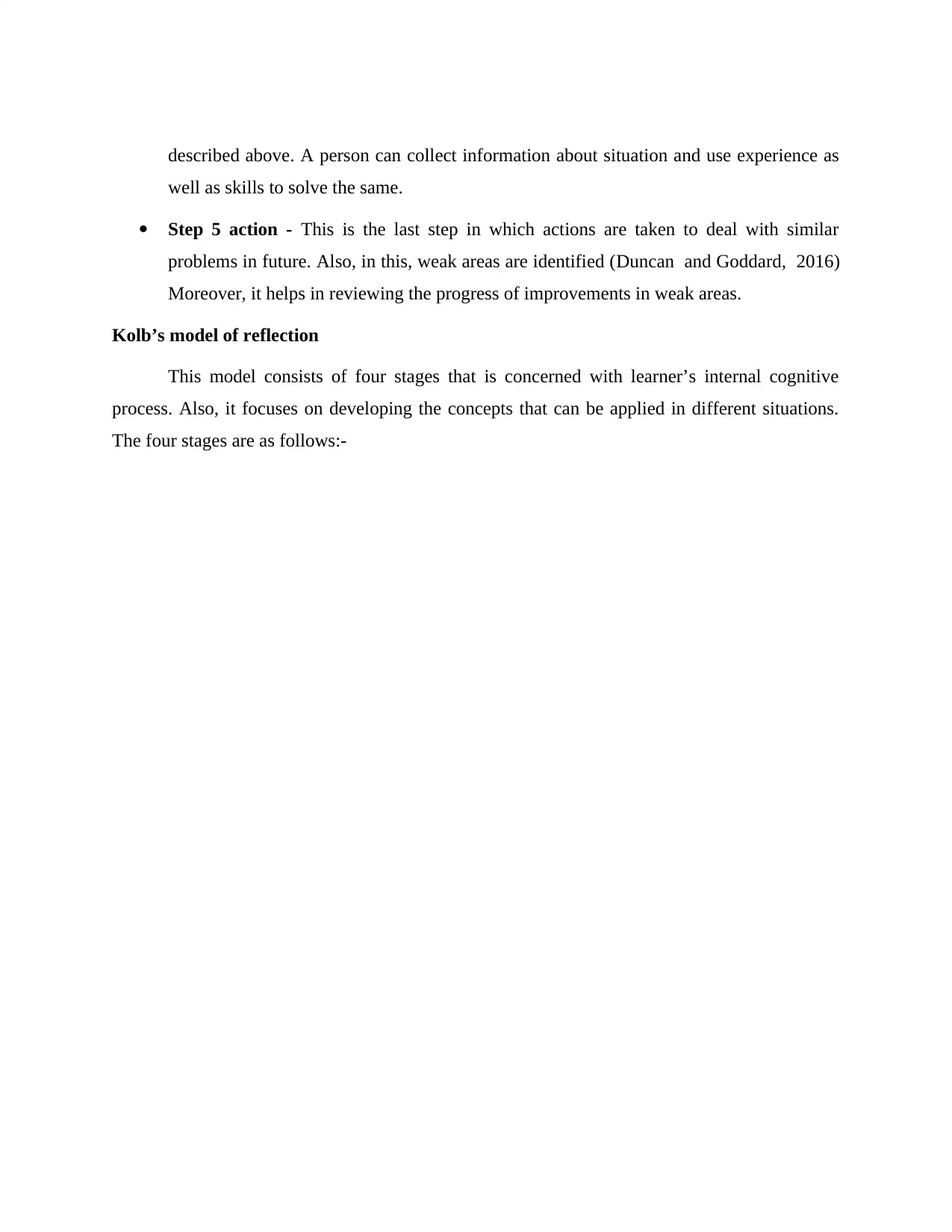
described above. A person can collect information about situation and use experience as
well as skills to solve the same.
Step 5 action - This is the last step in which actions are taken to deal with similar
problems in future. Also, in this, weak areas are identified (Duncan and Goddard, 2016)
Moreover, it helps in reviewing the progress of improvements in weak areas.
Kolb’s model of reflection
This model consists of four stages that is concerned with learner’s internal cognitive
process. Also, it focuses on developing the concepts that can be applied in different situations.
The four stages are as follows:-
well as skills to solve the same.
Step 5 action - This is the last step in which actions are taken to deal with similar
problems in future. Also, in this, weak areas are identified (Duncan and Goddard, 2016)
Moreover, it helps in reviewing the progress of improvements in weak areas.
Kolb’s model of reflection
This model consists of four stages that is concerned with learner’s internal cognitive
process. Also, it focuses on developing the concepts that can be applied in different situations.
The four stages are as follows:-
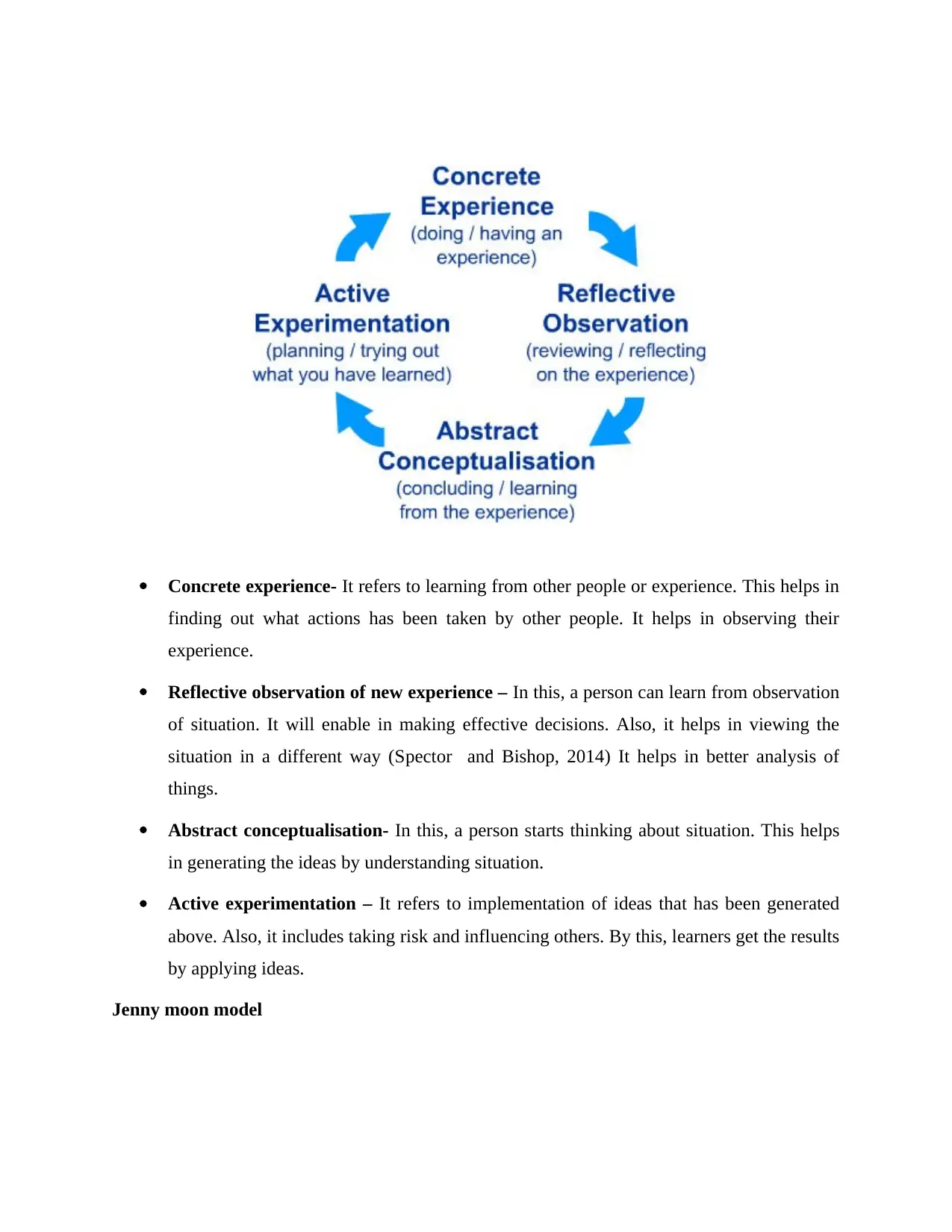
Concrete experience- It refers to learning from other people or experience. This helps in
finding out what actions has been taken by other people. It helps in observing their
experience.
Reflective observation of new experience – In this, a person can learn from observation
of situation. It will enable in making effective decisions. Also, it helps in viewing the
situation in a different way (Spector and Bishop, 2014) It helps in better analysis of
things.
Abstract conceptualisation- In this, a person starts thinking about situation. This helps
in generating the ideas by understanding situation.
Active experimentation – It refers to implementation of ideas that has been generated
above. Also, it includes taking risk and influencing others. By this, learners get the results
by applying ideas.
Jenny moon model
finding out what actions has been taken by other people. It helps in observing their
experience.
Reflective observation of new experience – In this, a person can learn from observation
of situation. It will enable in making effective decisions. Also, it helps in viewing the
situation in a different way (Spector and Bishop, 2014) It helps in better analysis of
things.
Abstract conceptualisation- In this, a person starts thinking about situation. This helps
in generating the ideas by understanding situation.
Active experimentation – It refers to implementation of ideas that has been generated
above. Also, it includes taking risk and influencing others. By this, learners get the results
by applying ideas.
Jenny moon model
⊘ This is a preview!⊘
Do you want full access?
Subscribe today to unlock all pages.

Trusted by 1+ million students worldwide
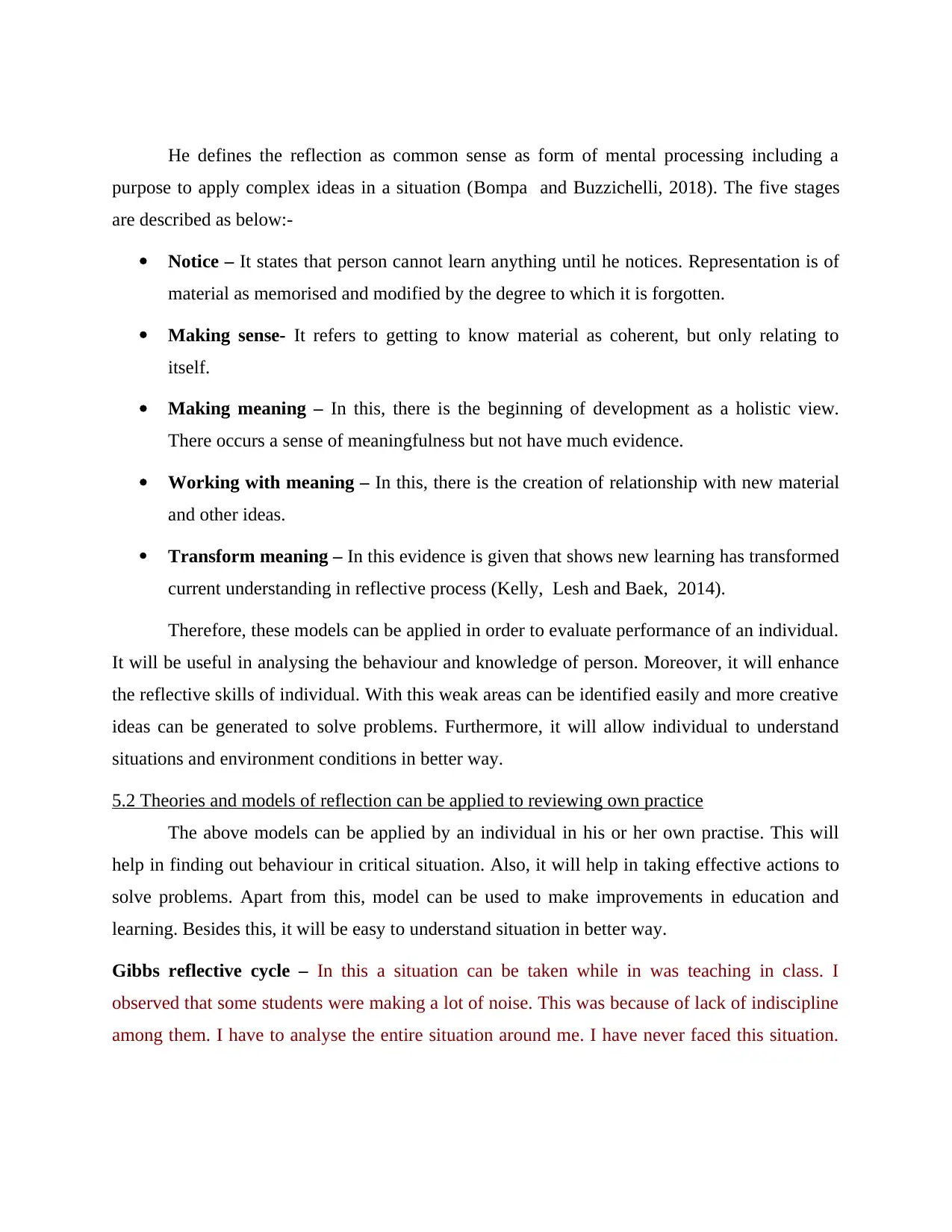
He defines the reflection as common sense as form of mental processing including a
purpose to apply complex ideas in a situation (Bompa and Buzzichelli, 2018). The five stages
are described as below:-
Notice – It states that person cannot learn anything until he notices. Representation is of
material as memorised and modified by the degree to which it is forgotten.
Making sense- It refers to getting to know material as coherent, but only relating to
itself.
Making meaning – In this, there is the beginning of development as a holistic view.
There occurs a sense of meaningfulness but not have much evidence.
Working with meaning – In this, there is the creation of relationship with new material
and other ideas.
Transform meaning – In this evidence is given that shows new learning has transformed
current understanding in reflective process (Kelly, Lesh and Baek, 2014).
Therefore, these models can be applied in order to evaluate performance of an individual.
It will be useful in analysing the behaviour and knowledge of person. Moreover, it will enhance
the reflective skills of individual. With this weak areas can be identified easily and more creative
ideas can be generated to solve problems. Furthermore, it will allow individual to understand
situations and environment conditions in better way.
5.2 Theories and models of reflection can be applied to reviewing own practice
The above models can be applied by an individual in his or her own practise. This will
help in finding out behaviour in critical situation. Also, it will help in taking effective actions to
solve problems. Apart from this, model can be used to make improvements in education and
learning. Besides this, it will be easy to understand situation in better way.
Gibbs reflective cycle – In this a situation can be taken while in was teaching in class. I
observed that some students were making a lot of noise. This was because of lack of indiscipline
among them. I have to analyse the entire situation around me. I have never faced this situation.
purpose to apply complex ideas in a situation (Bompa and Buzzichelli, 2018). The five stages
are described as below:-
Notice – It states that person cannot learn anything until he notices. Representation is of
material as memorised and modified by the degree to which it is forgotten.
Making sense- It refers to getting to know material as coherent, but only relating to
itself.
Making meaning – In this, there is the beginning of development as a holistic view.
There occurs a sense of meaningfulness but not have much evidence.
Working with meaning – In this, there is the creation of relationship with new material
and other ideas.
Transform meaning – In this evidence is given that shows new learning has transformed
current understanding in reflective process (Kelly, Lesh and Baek, 2014).
Therefore, these models can be applied in order to evaluate performance of an individual.
It will be useful in analysing the behaviour and knowledge of person. Moreover, it will enhance
the reflective skills of individual. With this weak areas can be identified easily and more creative
ideas can be generated to solve problems. Furthermore, it will allow individual to understand
situations and environment conditions in better way.
5.2 Theories and models of reflection can be applied to reviewing own practice
The above models can be applied by an individual in his or her own practise. This will
help in finding out behaviour in critical situation. Also, it will help in taking effective actions to
solve problems. Apart from this, model can be used to make improvements in education and
learning. Besides this, it will be easy to understand situation in better way.
Gibbs reflective cycle – In this a situation can be taken while in was teaching in class. I
observed that some students were making a lot of noise. This was because of lack of indiscipline
among them. I have to analyse the entire situation around me. I have never faced this situation.
Paraphrase This Document
Need a fresh take? Get an instant paraphrase of this document with our AI Paraphraser
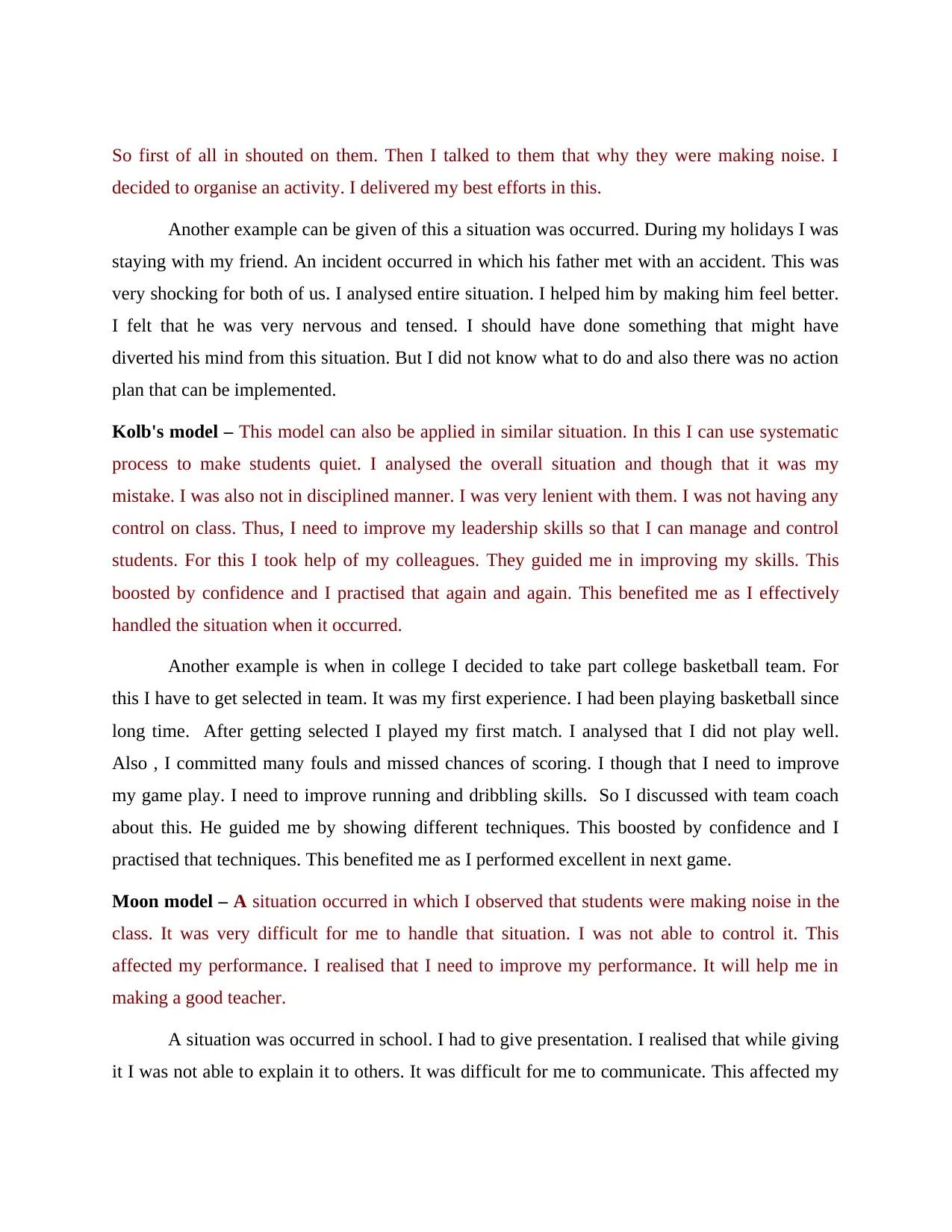
So first of all in shouted on them. Then I talked to them that why they were making noise. I
decided to organise an activity. I delivered my best efforts in this.
Another example can be given of this a situation was occurred. During my holidays I was
staying with my friend. An incident occurred in which his father met with an accident. This was
very shocking for both of us. I analysed entire situation. I helped him by making him feel better.
I felt that he was very nervous and tensed. I should have done something that might have
diverted his mind from this situation. But I did not know what to do and also there was no action
plan that can be implemented.
Kolb's model – This model can also be applied in similar situation. In this I can use systematic
process to make students quiet. I analysed the overall situation and though that it was my
mistake. I was also not in disciplined manner. I was very lenient with them. I was not having any
control on class. Thus, I need to improve my leadership skills so that I can manage and control
students. For this I took help of my colleagues. They guided me in improving my skills. This
boosted by confidence and I practised that again and again. This benefited me as I effectively
handled the situation when it occurred.
Another example is when in college I decided to take part college basketball team. For
this I have to get selected in team. It was my first experience. I had been playing basketball since
long time. After getting selected I played my first match. I analysed that I did not play well.
Also , I committed many fouls and missed chances of scoring. I though that I need to improve
my game play. I need to improve running and dribbling skills. So I discussed with team coach
about this. He guided me by showing different techniques. This boosted by confidence and I
practised that techniques. This benefited me as I performed excellent in next game.
Moon model – A situation occurred in which I observed that students were making noise in the
class. It was very difficult for me to handle that situation. I was not able to control it. This
affected my performance. I realised that I need to improve my performance. It will help me in
making a good teacher.
A situation was occurred in school. I had to give presentation. I realised that while giving
it I was not able to explain it to others. It was difficult for me to communicate. This affected my
decided to organise an activity. I delivered my best efforts in this.
Another example can be given of this a situation was occurred. During my holidays I was
staying with my friend. An incident occurred in which his father met with an accident. This was
very shocking for both of us. I analysed entire situation. I helped him by making him feel better.
I felt that he was very nervous and tensed. I should have done something that might have
diverted his mind from this situation. But I did not know what to do and also there was no action
plan that can be implemented.
Kolb's model – This model can also be applied in similar situation. In this I can use systematic
process to make students quiet. I analysed the overall situation and though that it was my
mistake. I was also not in disciplined manner. I was very lenient with them. I was not having any
control on class. Thus, I need to improve my leadership skills so that I can manage and control
students. For this I took help of my colleagues. They guided me in improving my skills. This
boosted by confidence and I practised that again and again. This benefited me as I effectively
handled the situation when it occurred.
Another example is when in college I decided to take part college basketball team. For
this I have to get selected in team. It was my first experience. I had been playing basketball since
long time. After getting selected I played my first match. I analysed that I did not play well.
Also , I committed many fouls and missed chances of scoring. I though that I need to improve
my game play. I need to improve running and dribbling skills. So I discussed with team coach
about this. He guided me by showing different techniques. This boosted by confidence and I
practised that techniques. This benefited me as I performed excellent in next game.
Moon model – A situation occurred in which I observed that students were making noise in the
class. It was very difficult for me to handle that situation. I was not able to control it. This
affected my performance. I realised that I need to improve my performance. It will help me in
making a good teacher.
A situation was occurred in school. I had to give presentation. I realised that while giving
it I was not able to explain it to others. It was difficult for me to communicate. This affected my
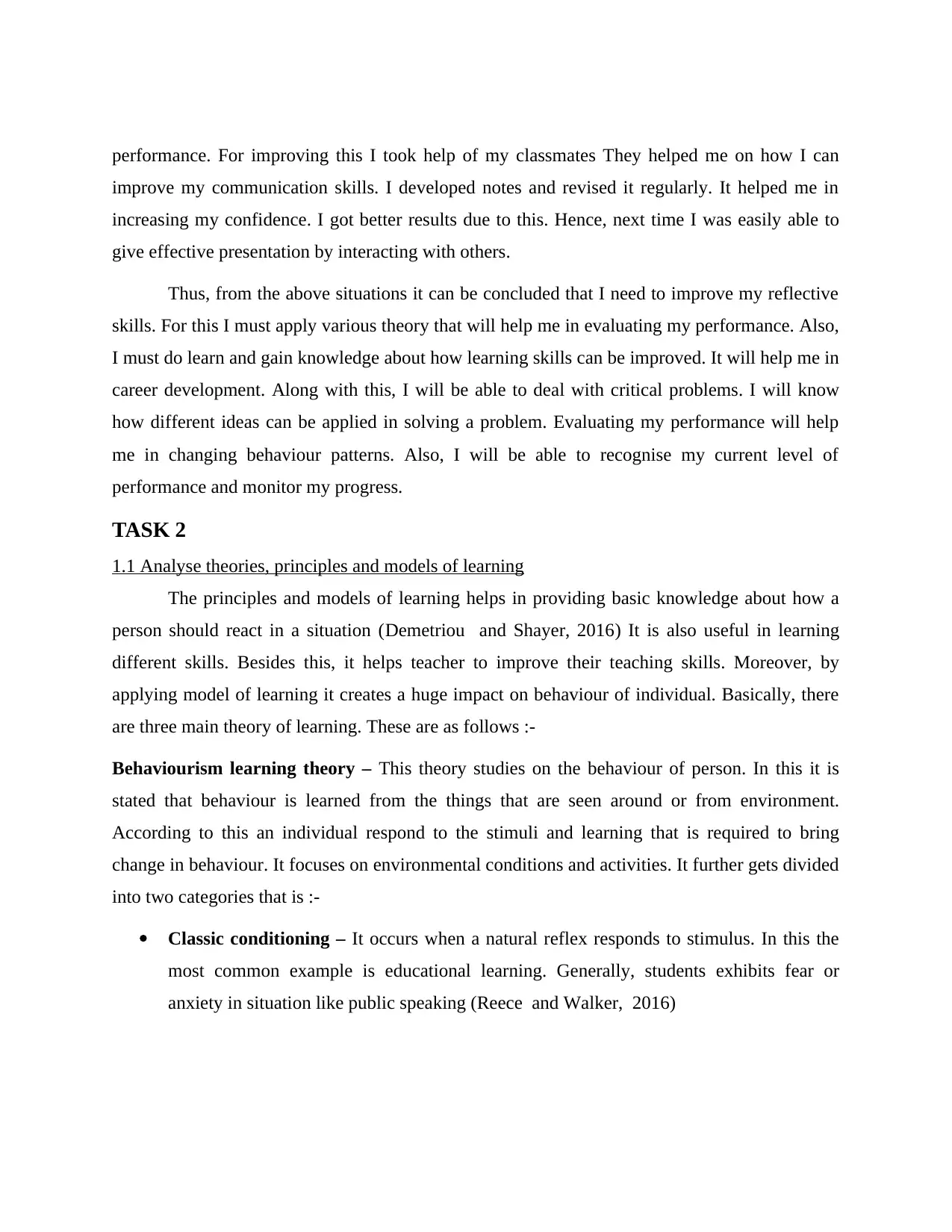
performance. For improving this I took help of my classmates They helped me on how I can
improve my communication skills. I developed notes and revised it regularly. It helped me in
increasing my confidence. I got better results due to this. Hence, next time I was easily able to
give effective presentation by interacting with others.
Thus, from the above situations it can be concluded that I need to improve my reflective
skills. For this I must apply various theory that will help me in evaluating my performance. Also,
I must do learn and gain knowledge about how learning skills can be improved. It will help me in
career development. Along with this, I will be able to deal with critical problems. I will know
how different ideas can be applied in solving a problem. Evaluating my performance will help
me in changing behaviour patterns. Also, I will be able to recognise my current level of
performance and monitor my progress.
TASK 2
1.1 Analyse theories, principles and models of learning
The principles and models of learning helps in providing basic knowledge about how a
person should react in a situation (Demetriou and Shayer, 2016) It is also useful in learning
different skills. Besides this, it helps teacher to improve their teaching skills. Moreover, by
applying model of learning it creates a huge impact on behaviour of individual. Basically, there
are three main theory of learning. These are as follows :-
Behaviourism learning theory – This theory studies on the behaviour of person. In this it is
stated that behaviour is learned from the things that are seen around or from environment.
According to this an individual respond to the stimuli and learning that is required to bring
change in behaviour. It focuses on environmental conditions and activities. It further gets divided
into two categories that is :-
Classic conditioning – It occurs when a natural reflex responds to stimulus. In this the
most common example is educational learning. Generally, students exhibits fear or
anxiety in situation like public speaking (Reece and Walker, 2016)
improve my communication skills. I developed notes and revised it regularly. It helped me in
increasing my confidence. I got better results due to this. Hence, next time I was easily able to
give effective presentation by interacting with others.
Thus, from the above situations it can be concluded that I need to improve my reflective
skills. For this I must apply various theory that will help me in evaluating my performance. Also,
I must do learn and gain knowledge about how learning skills can be improved. It will help me in
career development. Along with this, I will be able to deal with critical problems. I will know
how different ideas can be applied in solving a problem. Evaluating my performance will help
me in changing behaviour patterns. Also, I will be able to recognise my current level of
performance and monitor my progress.
TASK 2
1.1 Analyse theories, principles and models of learning
The principles and models of learning helps in providing basic knowledge about how a
person should react in a situation (Demetriou and Shayer, 2016) It is also useful in learning
different skills. Besides this, it helps teacher to improve their teaching skills. Moreover, by
applying model of learning it creates a huge impact on behaviour of individual. Basically, there
are three main theory of learning. These are as follows :-
Behaviourism learning theory – This theory studies on the behaviour of person. In this it is
stated that behaviour is learned from the things that are seen around or from environment.
According to this an individual respond to the stimuli and learning that is required to bring
change in behaviour. It focuses on environmental conditions and activities. It further gets divided
into two categories that is :-
Classic conditioning – It occurs when a natural reflex responds to stimulus. In this the
most common example is educational learning. Generally, students exhibits fear or
anxiety in situation like public speaking (Reece and Walker, 2016)
⊘ This is a preview!⊘
Do you want full access?
Subscribe today to unlock all pages.

Trusted by 1+ million students worldwide
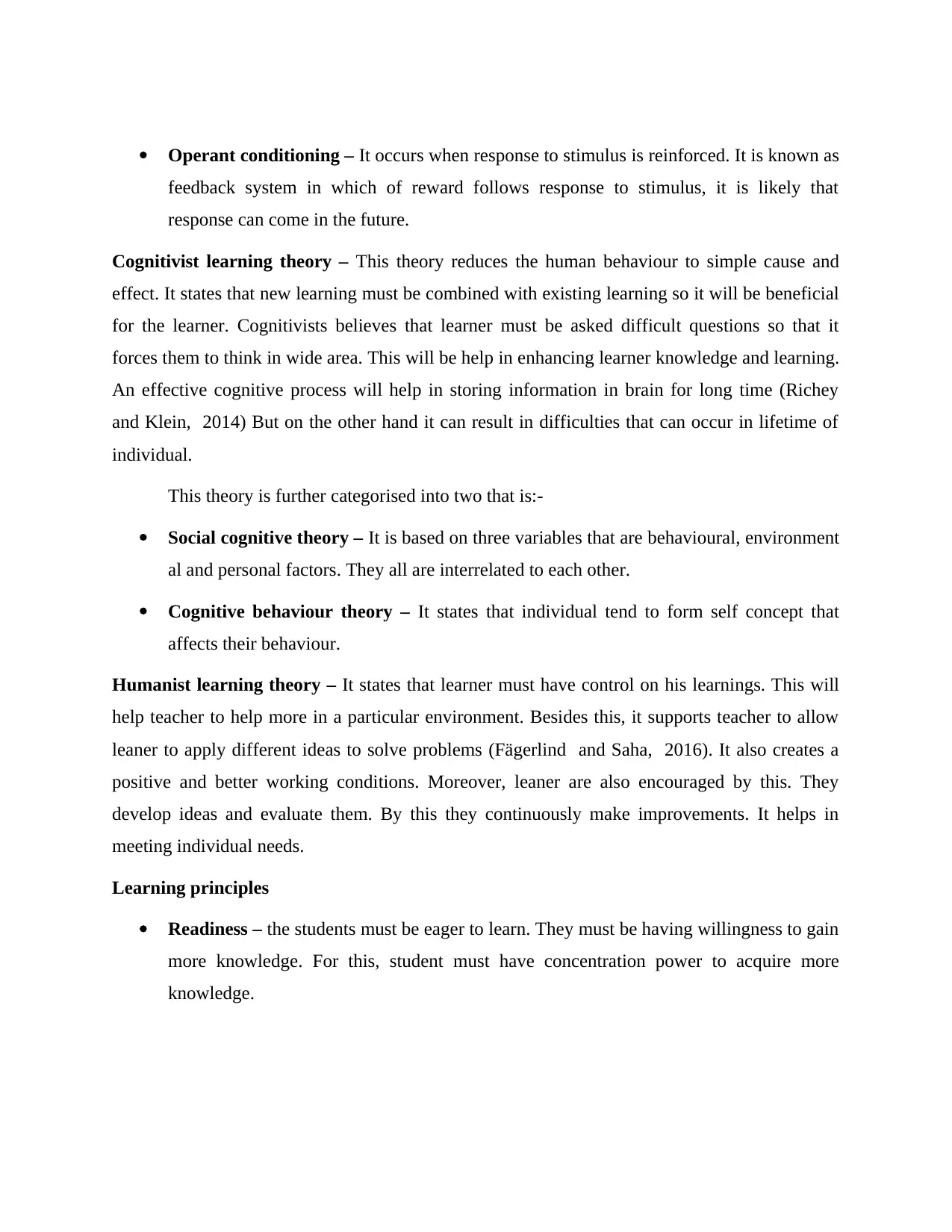
Operant conditioning – It occurs when response to stimulus is reinforced. It is known as
feedback system in which of reward follows response to stimulus, it is likely that
response can come in the future.
Cognitivist learning theory – This theory reduces the human behaviour to simple cause and
effect. It states that new learning must be combined with existing learning so it will be beneficial
for the learner. Cognitivists believes that learner must be asked difficult questions so that it
forces them to think in wide area. This will be help in enhancing learner knowledge and learning.
An effective cognitive process will help in storing information in brain for long time (Richey
and Klein, 2014) But on the other hand it can result in difficulties that can occur in lifetime of
individual.
This theory is further categorised into two that is:-
Social cognitive theory – It is based on three variables that are behavioural, environment
al and personal factors. They all are interrelated to each other.
Cognitive behaviour theory – It states that individual tend to form self concept that
affects their behaviour.
Humanist learning theory – It states that learner must have control on his learnings. This will
help teacher to help more in a particular environment. Besides this, it supports teacher to allow
leaner to apply different ideas to solve problems (Fägerlind and Saha, 2016). It also creates a
positive and better working conditions. Moreover, leaner are also encouraged by this. They
develop ideas and evaluate them. By this they continuously make improvements. It helps in
meeting individual needs.
Learning principles
Readiness – the students must be eager to learn. They must be having willingness to gain
more knowledge. For this, student must have concentration power to acquire more
knowledge.
feedback system in which of reward follows response to stimulus, it is likely that
response can come in the future.
Cognitivist learning theory – This theory reduces the human behaviour to simple cause and
effect. It states that new learning must be combined with existing learning so it will be beneficial
for the learner. Cognitivists believes that learner must be asked difficult questions so that it
forces them to think in wide area. This will be help in enhancing learner knowledge and learning.
An effective cognitive process will help in storing information in brain for long time (Richey
and Klein, 2014) But on the other hand it can result in difficulties that can occur in lifetime of
individual.
This theory is further categorised into two that is:-
Social cognitive theory – It is based on three variables that are behavioural, environment
al and personal factors. They all are interrelated to each other.
Cognitive behaviour theory – It states that individual tend to form self concept that
affects their behaviour.
Humanist learning theory – It states that learner must have control on his learnings. This will
help teacher to help more in a particular environment. Besides this, it supports teacher to allow
leaner to apply different ideas to solve problems (Fägerlind and Saha, 2016). It also creates a
positive and better working conditions. Moreover, leaner are also encouraged by this. They
develop ideas and evaluate them. By this they continuously make improvements. It helps in
meeting individual needs.
Learning principles
Readiness – the students must be eager to learn. They must be having willingness to gain
more knowledge. For this, student must have concentration power to acquire more
knowledge.
Paraphrase This Document
Need a fresh take? Get an instant paraphrase of this document with our AI Paraphraser
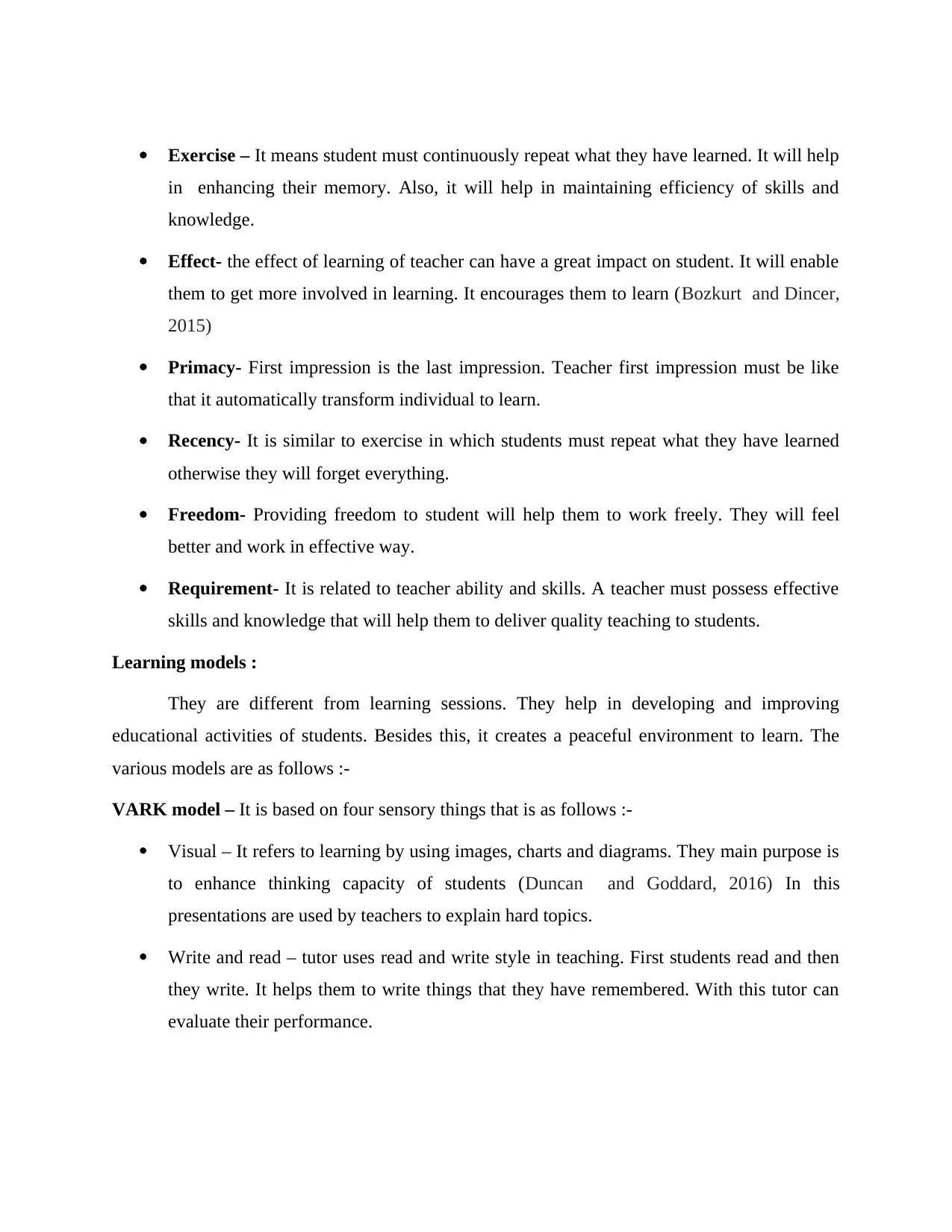
Exercise – It means student must continuously repeat what they have learned. It will help
in enhancing their memory. Also, it will help in maintaining efficiency of skills and
knowledge.
Effect- the effect of learning of teacher can have a great impact on student. It will enable
them to get more involved in learning. It encourages them to learn (Bozkurt and Dincer,
2015)
Primacy- First impression is the last impression. Teacher first impression must be like
that it automatically transform individual to learn.
Recency- It is similar to exercise in which students must repeat what they have learned
otherwise they will forget everything.
Freedom- Providing freedom to student will help them to work freely. They will feel
better and work in effective way.
Requirement- It is related to teacher ability and skills. A teacher must possess effective
skills and knowledge that will help them to deliver quality teaching to students.
Learning models :
They are different from learning sessions. They help in developing and improving
educational activities of students. Besides this, it creates a peaceful environment to learn. The
various models are as follows :-
VARK model – It is based on four sensory things that is as follows :-
Visual – It refers to learning by using images, charts and diagrams. They main purpose is
to enhance thinking capacity of students (Duncan and Goddard, 2016) In this
presentations are used by teachers to explain hard topics.
Write and read – tutor uses read and write style in teaching. First students read and then
they write. It helps them to write things that they have remembered. With this tutor can
evaluate their performance.
in enhancing their memory. Also, it will help in maintaining efficiency of skills and
knowledge.
Effect- the effect of learning of teacher can have a great impact on student. It will enable
them to get more involved in learning. It encourages them to learn (Bozkurt and Dincer,
2015)
Primacy- First impression is the last impression. Teacher first impression must be like
that it automatically transform individual to learn.
Recency- It is similar to exercise in which students must repeat what they have learned
otherwise they will forget everything.
Freedom- Providing freedom to student will help them to work freely. They will feel
better and work in effective way.
Requirement- It is related to teacher ability and skills. A teacher must possess effective
skills and knowledge that will help them to deliver quality teaching to students.
Learning models :
They are different from learning sessions. They help in developing and improving
educational activities of students. Besides this, it creates a peaceful environment to learn. The
various models are as follows :-
VARK model – It is based on four sensory things that is as follows :-
Visual – It refers to learning by using images, charts and diagrams. They main purpose is
to enhance thinking capacity of students (Duncan and Goddard, 2016) In this
presentations are used by teachers to explain hard topics.
Write and read – tutor uses read and write style in teaching. First students read and then
they write. It helps them to write things that they have remembered. With this tutor can
evaluate their performance.
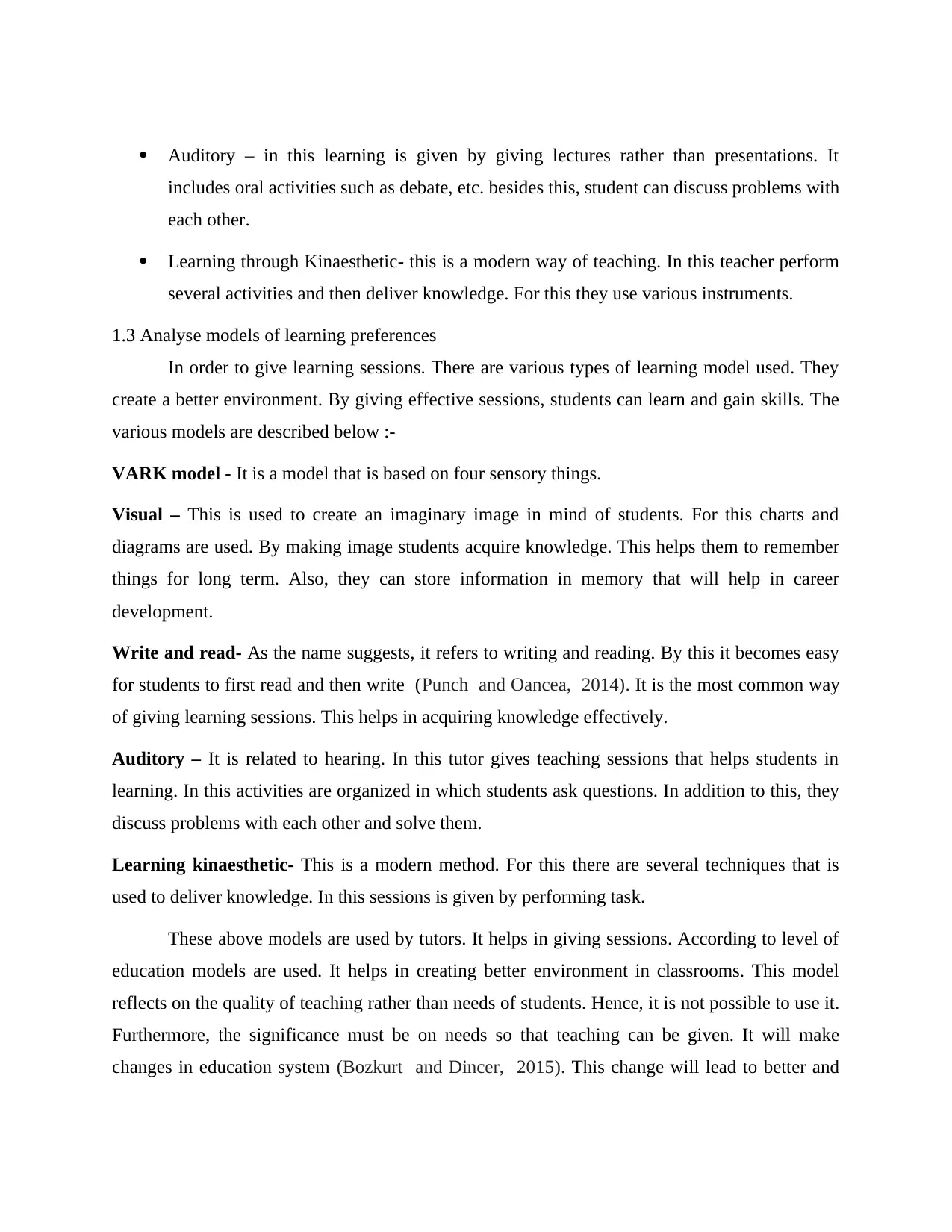
Auditory – in this learning is given by giving lectures rather than presentations. It
includes oral activities such as debate, etc. besides this, student can discuss problems with
each other.
Learning through Kinaesthetic- this is a modern way of teaching. In this teacher perform
several activities and then deliver knowledge. For this they use various instruments.
1.3 Analyse models of learning preferences
In order to give learning sessions. There are various types of learning model used. They
create a better environment. By giving effective sessions, students can learn and gain skills. The
various models are described below :-
VARK model - It is a model that is based on four sensory things.
Visual – This is used to create an imaginary image in mind of students. For this charts and
diagrams are used. By making image students acquire knowledge. This helps them to remember
things for long term. Also, they can store information in memory that will help in career
development.
Write and read- As the name suggests, it refers to writing and reading. By this it becomes easy
for students to first read and then write (Punch and Oancea, 2014). It is the most common way
of giving learning sessions. This helps in acquiring knowledge effectively.
Auditory – It is related to hearing. In this tutor gives teaching sessions that helps students in
learning. In this activities are organized in which students ask questions. In addition to this, they
discuss problems with each other and solve them.
Learning kinaesthetic- This is a modern method. For this there are several techniques that is
used to deliver knowledge. In this sessions is given by performing task.
These above models are used by tutors. It helps in giving sessions. According to level of
education models are used. It helps in creating better environment in classrooms. This model
reflects on the quality of teaching rather than needs of students. Hence, it is not possible to use it.
Furthermore, the significance must be on needs so that teaching can be given. It will make
changes in education system (Bozkurt and Dincer, 2015). This change will lead to better and
includes oral activities such as debate, etc. besides this, student can discuss problems with
each other.
Learning through Kinaesthetic- this is a modern way of teaching. In this teacher perform
several activities and then deliver knowledge. For this they use various instruments.
1.3 Analyse models of learning preferences
In order to give learning sessions. There are various types of learning model used. They
create a better environment. By giving effective sessions, students can learn and gain skills. The
various models are described below :-
VARK model - It is a model that is based on four sensory things.
Visual – This is used to create an imaginary image in mind of students. For this charts and
diagrams are used. By making image students acquire knowledge. This helps them to remember
things for long term. Also, they can store information in memory that will help in career
development.
Write and read- As the name suggests, it refers to writing and reading. By this it becomes easy
for students to first read and then write (Punch and Oancea, 2014). It is the most common way
of giving learning sessions. This helps in acquiring knowledge effectively.
Auditory – It is related to hearing. In this tutor gives teaching sessions that helps students in
learning. In this activities are organized in which students ask questions. In addition to this, they
discuss problems with each other and solve them.
Learning kinaesthetic- This is a modern method. For this there are several techniques that is
used to deliver knowledge. In this sessions is given by performing task.
These above models are used by tutors. It helps in giving sessions. According to level of
education models are used. It helps in creating better environment in classrooms. This model
reflects on the quality of teaching rather than needs of students. Hence, it is not possible to use it.
Furthermore, the significance must be on needs so that teaching can be given. It will make
changes in education system (Bozkurt and Dincer, 2015). This change will lead to better and
⊘ This is a preview!⊘
Do you want full access?
Subscribe today to unlock all pages.

Trusted by 1+ million students worldwide
1 out of 30
Related Documents
Your All-in-One AI-Powered Toolkit for Academic Success.
+13062052269
info@desklib.com
Available 24*7 on WhatsApp / Email
![[object Object]](/_next/static/media/star-bottom.7253800d.svg)
Unlock your academic potential
Copyright © 2020–2025 A2Z Services. All Rights Reserved. Developed and managed by ZUCOL.


